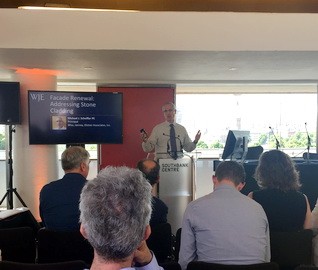Solving for Why
A Janney Technical Center Video Series


Solving for Why: Pressure Wall Testing
Architect Tony Cinnamon explains how pressure wall testing helps us evaluate a variety of building materials and systems.
SOLVING FOR WHY: Analyzing Materials with Gas Chromatography Mass Spectrometry
Chemist Mat Starczewski demonstrates the use of gas chromatography mass spectrometry (GCMS) to evaluate the chemical composition of organic materials.
SOLVING FOR WHY: Chloride Testing of Cementitious Materials
Chemistry technician Carl Jasieniecki demonstrates a chloride test and discusses how we use the results to develop service life models and repair and remediation recommendations.
SOLVING FOR WHY: High Voltage Electronic Leak Detection
Roofing consultant Pat Giblin demonstrates using high voltage electronic leak detection to locate pinholes in a roof membrane.
SOLVING FOR WHY: Pressurized Water Penetration Testing
Architect and structural engineer Kevin Kalata demonstrates pressurized water penetration testing on a window assembly, simulating wind-driven rain to verify its performance prior to installation.
Solving for Why: Whole Building Air Leakage Testing
Building scientist Justin Boone demonstrates a whole building air leakage test and explains how the data collected helps owners make their buildings more air tight and energy efficient.
Solving for Why: Thermal Imaging of Roofs
Senior specialist David Felleti explains infrared thermography and how we use it to detect the presence of moisture inside a roofing membrane.
SOLVING FOR WHY: Determining the Source of Leaks with Ion Chromatography
Senior technician Jesus Lagunas explains how we analyze the ionic profile of a water sample to identify the source of a leak.
Solving for Why: Pull-Off Adhesion Testing of Coatings
Chemist Leonard Phelps performs a pull-off adhesion test of a paint coating to determine the load necessary to pull the paint coating off, the resulting stress level, and the type of failure that occurs.
Solving for Why: Fitness for Service Assessments
Mechanical engineer Scott Bouse describes how we performed a fitness for service assessment to project remaining service life and instruct a client's repair strategy.
Solving for Why: Differential Scanning Calorimetry
Chemist Jeff Plumridge demonstrates the use of differential scanning calorimetry to measure the degree of oxidation in a plastic pipe that prematurely failed while in service.
Solving for Why: Concrete Curing in the Lab
Materials engineer Elizabeth Wagner demonstrates how WJE cures concrete in our laboratory to determine how it will perform in the field or to confirm the characteristics of recently placed concrete.
Solving for Why: Scanning Electron Microscopy
Petrographer Hugh Hou and metallurgist David Schmit demonstrate how they use scanning electron microscopy to characterize the chemical composition of distressed concrete and identify corrosive elements in piping.
Solving for Why: Tensile Test of Seven-Wire Steel Strand
Structural engineer John Pearson loads a seven-wire steel strand to failure, demonstrating a common test performed in the JTC structural laboratory.
Solving for Why: Metallographic Weld Evaluation
Metallurgist Jon Hovde examines the microstructure of a prematurely failed weld to determine the cause of the failure and to develop a prevention strategy.
Solving for Why: Locating Embedded Metals in Reinforced Concrete Structures
Structural engineer Thomas Frankie demonstrates the use of one nondestructive evaluation tool—a hand-held ground penetrating radar unit—to locate as-built structural elements in a historic building lacking original construction drawings.
Solving for Why: Concrete Compressive Strength Testing
Materials engineer Todd Nelson demonstrates proper concrete core sample preparation followed by destructive testing to measure its compressive strength.
Solving for Why: Vibration Monitoring to Locate Building Noises
Engineer Bob Hannen explains how a series of accelerometers and a proprietary vibration monitoring program can be used to triangulate the source of bothersome or mysterious building noises.
SOLVING FOR WHY: Detecting Voids in Slabs with Ground Penetrating Radar
Senior specialist Dan Wetherington demonstrates the use of GPR and discusses how we interpret and use the data collected.
SOLVING FOR WHY: Corrosion Evaluation of Reinforced Concrete
Engineer Stephen Garrett demonstrates three assessment methods for evaluating corrosion of reinforced concrete structures: half cell potential testing, surface resistivity testing, and instantaneous corrosion rate measurement.
SOLVING FOR WHY: Vacuum Chamber Glass Test
Instrumentation specialist Roger Pelletier demonstrates a vacuum chamber test: loading a glass window to failure to determine whether noted surface conditions significantly affected the glass's structural integrity.
SOLVING FOR WHY: Atomic Absorption Spectroscopy
Chemist Tonya Werner demonstrates the use of our atomic absorption instrument to identify the concentration of different elements in a mortar sample.
SOLVING FOR WHY: Monotonic tension test
Structural engineer Scott Graham demonstrates a monotonic tension test—pulling rebar apart until it breaks—using our Tinius Olsen test machine.
SOLVING FOR WHY: Evaluating Water-to-Cement Ratio
Petrographers Daniela Mauro and George Reo demonstrate a series of evaluations performed to judge the durability of a concrete core.
Solving for why: ACCELERATED WEATHERING TO TEST STONE DURABILITY
Architect Daren Kneezel explains the process by which we test the durability of dimension stone cladding.
SOLVING FOR WHY: MATERIAL IDENTIFICATION USING FTIR
Chemist Kim Steiner walks through one method used to identify materials.



































